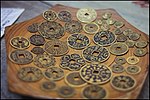 | simplified Chinese: 铅钱; pinyin: qiān qián; Vietnamese: Duyên tiền; Japanese: 鉛銭 (なまりせん); Rōmaji: Namarisen) are a type of Chinese, Japanese, and Vietnamese... 60 KB (6,641 words) - 20:37, 13 May 2024 |
 | Japanese numismatic charms (Japanese: 絵銭 or 画銭), also known as Japanese amulets, Japanese talismans, or simply Japanese charms, refer to a family of cash... 11 KB (1,168 words) - 22:35, 8 May 2024 |
 | Hongwu Tongbao (redirect from 加治木銭) Japan a large number of imported Ming dynasty cash coins (明銭) started circulating as Shichūsen (私鋳銭) from the sixteenth century. On the island of Kyushu a... 20 KB (1,922 words) - 02:43, 21 March 2023 |





